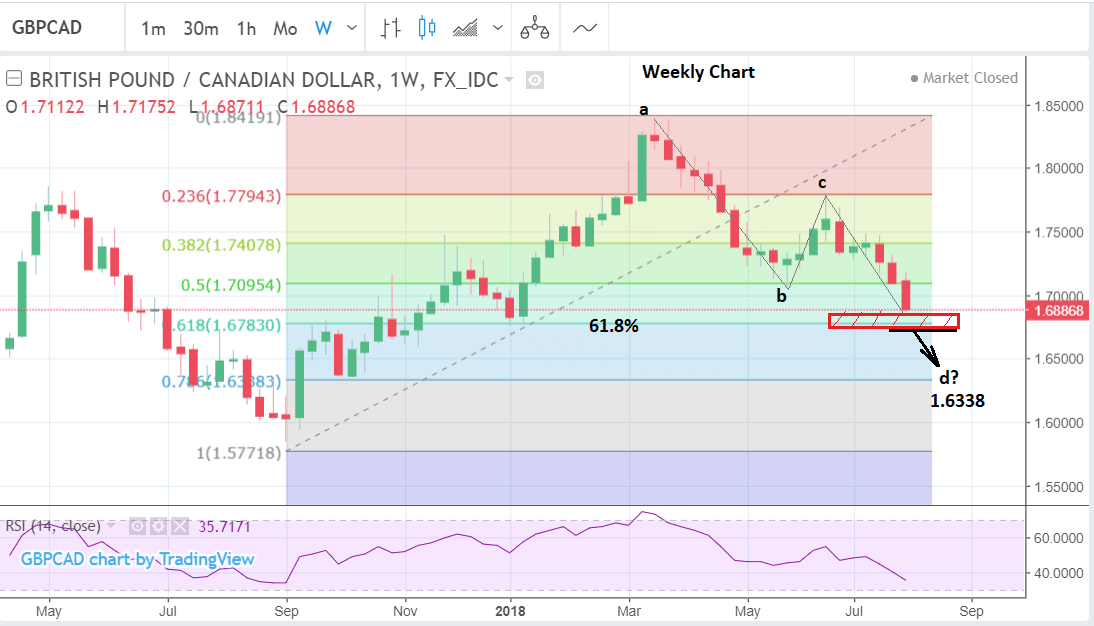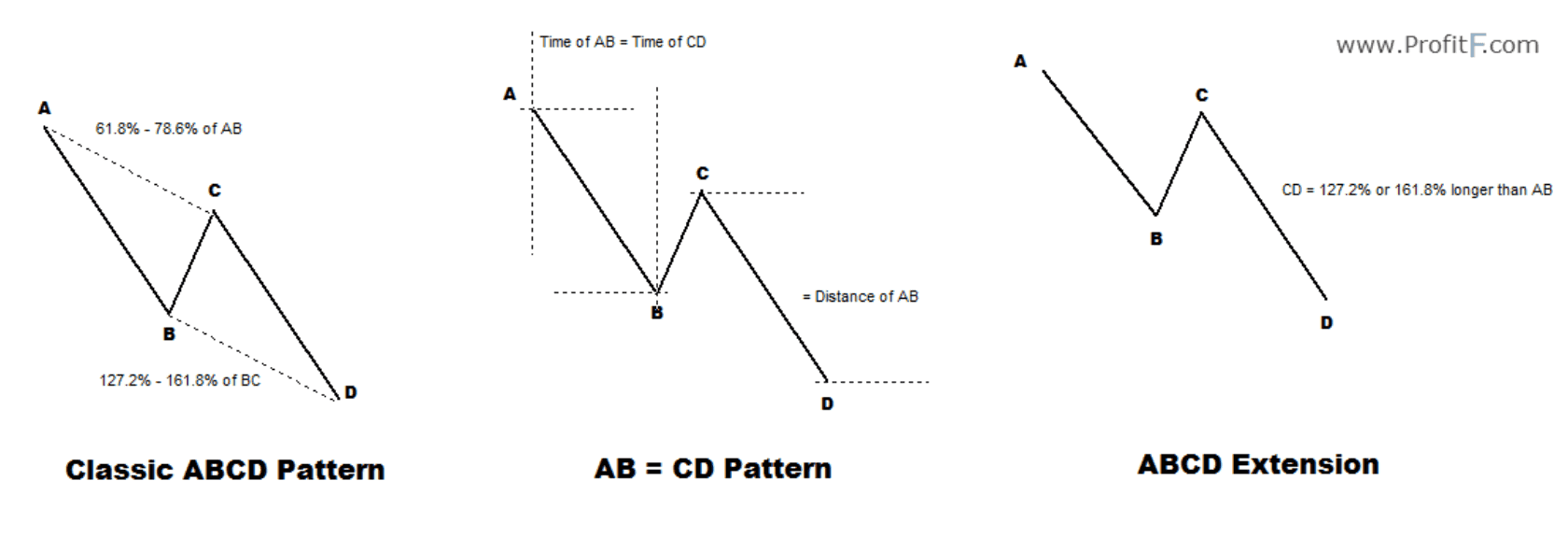The Pound-to-Canadian Dollar Rate 5 Day Forecast: Expected to Extend Lower as CAD Strengthens

- GBP/CAD is now in established downtrend which is forecast to continue
- Support zone could stall the downtrend but a break below 1.6730 should confirm extension
- Main release for GBP is GDP data in Q2; for CAD, employment data stands out
The GBP/CAD pair continues to sell-off as the entrenched short-term downtrend extends.
From a fundamental perspective the Canadian Dollar has appreciated as a result of easing NAFTA risks as the US, Mexico and Canada appear to be close to reaching a deal on tariffing and origin of auto parts, at least according to a joint press conference of both Mexico and Canada's chief negotiators last week.
The Loonie had depreciated as a result of concerns the US would pull out of NAFTA completely and restrict Canadian imports, concerns which led the Bank of Canada (BOC) to shy away from raising interest rates despite rising growth and falling unemployment.
With risks now diminishing of a 'no-deal' outcome, however, the probability the BOC will raise rates has increased substantially, and this has supported last week's rally for the Loonie, and may support a continuation in the week ahead.
From a technical perspective, bar a few support levels, the picture looks bright for the Loonie vs the Pound (which translates as bearish for GBP/CAD).
The pair's downtrend is forecast continue with the proviso that it is now also reaching a zone of support where it may stall or even correct higher as it encounters technical buying.
The zone is made up of the 61.8% Fibonacci retracement from the rally between the September 2017 lows and March 2018 highs at 1.6783, and the expected end to a possible ABCD pattern the exchange rate may have been forming since it fell from the March highs.
Waves A-B and C-D of ABCDs are normally either the same length or related by a 61.8% proportion. In the case of the ABCD forming on GBP/CAD the C-D leg is now almost 61.8% the length of A-B suggesting a potential endpoint and the start of a reversal higher.
It equalled 61.8% of A-B at 1.6935, a level now broken as the current exchange rate is below at 1.6887. Of course, alternatively, it is also possible the pattern will extend lower to a target at 1.6338 where C-D will equal A-B.
If the pair successfully breaks below the 1.6730 level it will probably confirm a break below the 61.8% retracement and a continuation south the next target at the ABCD wave-equivalence target of 1.6338.
Advertisement
Get up to 5% more foreign exchange for international payments by using a specialist provider to get closer to the real market rate and avoid the gaping spreads charged by your bank when providing currency. Learn more here
What to Watch for the Canadian Dollar
The big release in the week ahead for the Canadian Dollar is employment data which is forecast to show a fall in unemployment to 5.9% (from 6.0% prev), a rise in overall employment of 17.5k, and a drop in the participation rate of a basis point to 65.4%, when it is released at 13.30 B.S.T on Friday, August 10.
Employment has a big impact on BOC policy. If unemployment falls, wages tend to rise which lifts inflation. The BOC is then more likely to lift interest rates to calm inflation and higher interest rates support a currency by increasing net inflows of foreign capital, drawn by the promise of higher returns.
A strong employment data release on Friday is likely to lift CAD and vice versa for the opposite.
Other major releases for the Loonie are the New Housing Price Index at 13.30 on Thursday, June Building permits at the same time on Wednesday, and the Ivey PMI - a general business activity survey - which is forecast to rise to 64.2 from 63.1 previously in June, suggesting healthy expansion.
The Calendar for the Pound
Last week's price action confirms the Pound is not really paying much attention to Bank of England interest rates, and thus economic activity.
Instead, persistent concerns of the shape of Brexit negotiations remain the key driver.
In the week ahead, therefore, the main focus is going to be on the odds of a 'no-deal' materialising.
Prime Minister Theresa May cut short her holiday to meet French president Emmanuel Macron at his Riviera retreat over the weekend in an effort to gain more support for her proposals.
In the week ahead there is likely to be much focus on the outcome of this meeting. Early signs are Mr Macron has made it clear he does not want to 'go over the head' of his chief negotiator Michel Barnier, so its questionable whether the meeting achieved any traction for May's plans.
Barnier has been critical of May's plan saying the idea of the UK collecting tariffs on behalf of the EU 'unworkable', but without this element of the deal the UK will not be able to forge unilateral trade deals with third parties, killing the dream of new alliances, and making it completely unpalatable to already-sceptical Brexiteers.
May has already had problems uniting her party behind her plan and there remain many dissenters who think her proposals are too concessionary.
She therefore lacks any further negotiating slack to compromise with the EU, and this is why governor Carney has raised his risk assessment of a 'no-deal' outcome.
May's has given as many concessions as she can, yet it's not far enough for the EU. An intractable deadlock appears to be the new threat on the horizon and currency markets are expressing this by keeping Sterling under pressure.
From a hard data perspective the week ahead is fairly quiet, which is likely to further magnify Brexit as a driver.
The main release is Q2 GDP on Friday August 10 at 9.30 B.S.T, which is forecast to show a 0.4% rise after Q1's disappointing 0.2%.
Q2 GDP will be important mainly as a benchmark for comparing Q1 - if it really does come out at 0.4% then everyone will be relieved at the rebound and those who said the slowdown in Q1 was just a 'blip' due to 'the weather', will be vindicated. If, however, Q2 also shows a slowdown then economists will start to wonder whether this part of a deeper more troubling decline. Sterling may react.
Other important data in the week ahead includes the Trade Balance in June, released at the same time as GDP, which is forecast to show a -11.95bn deficit versus -12.36bn previously.
Industrial production is also out at the same time and forecast to show a 0.4% rebound in June. Manufacturing production, likewise, out at the same time and expected to show a 0.3% rise in June.
The Royal Institute of Chartered Surveyors (RICS) house price monitor is out at 00.01 on Tuesday. it showed a 1.1% positive score in June. The RICS monitor is composed of survey answers from surveyors about whether they think house prices have gone up, down or no-change.
Business Investment on Friday at 9.30, Halifax house prices and the BRC Retail sales monitor are out on Tuesday, and New Car Sales on Monday morning at 8.00, are further releases on the UK economic calendar.
Advertisement
Get up to 5% more foreign exchange for international payments by using a specialist provider to get closer to the real market rate and avoid the gaping spreads charged by your bank when providing currency. Learn more here











